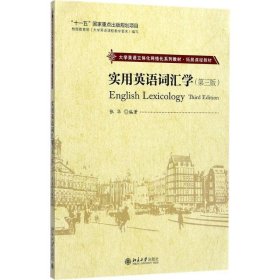
实用英语词汇学
¥ 5 1.3折 ¥ 39 九五品
仅1件
作者张华
出版社北京大学出版社
ISBN9787301286517
出版时间2017-08
版次1
装帧平装
开本16开
纸张胶版纸
页数252页
字数99999千字
定价39元
上书时间2024-05-03
- 最新上架
商品详情
- 品相描述:九五品
- 商品描述
-
基本信息
书名:实用英语词汇学
定价:39.00元
作者:张华
出版社:北京大学出版社
出版日期:2017-08-01
ISBN:9787301286517
字数:400000
页码:252
版次:3
装帧:平装
开本:16开
商品重量:
编辑推荐
内容提要
《实用英语词汇学(第三版)》全面地介绍了词汇学的基本概念、英语词汇的历史发展、词根词缀的构成、词汇意义、词汇意义的关系变化以及词义在语境中的作用。本书修订版一方面加强了词根和词缀部分的练习数量和难度以帮助学习者提高英语构词能力和词义理解能力,另一方面着重强调词汇意义与语境的关系,因为只有通过语篇尤其是大量真实语料的阅读才可以掌握词义。每章后配有相当数量的练习,可以有效地帮助学生了解词义在语篇中的关联,克服词汇理解在语篇阅读中的瓶颈,在阅读理解中寻找解决词汇问题的方法。
目录
Chapter 1 Lexicology and basic concepts of words and vocabulary 1.1 The definition of English lexicology 1.1.1 The domains of English lexicology 1.1.2 Methods of study of lexicology 1.2 The definition of word 1.3 The definition of vocabulary 1.4 Classification of words 1.4.1 Full word and form word 1.4.2 Popular word and learned word 1.4.3 Abstract word and concrete word 1.4.4 Transparent word and opaque word 1.4.5 Polysemic word and monosemic word 1.4.6 Native word and loan wordExercisesChapter 2 The development of the English vocabulary 2.1 The world languages 2.2 Language classifications 2.2.1 Morphological classificatio 2.2.2 Structural classificatio 2.3 The Indo-European Family 2.4 The historical overview of English vocabulary 2.5 Three main sources of new words of the present-day English vocabulary 2.5.1 The rapid development of modern science and technology 2.5.2 Social, economic and political changes 2.5.3 The influence of other cultures and languages 2.6 Three modes of vocabulary development 2.6.1 Creatio 2.6.2 Semantic change 2.6.3 BorrowingExercisesChapter 3 The structure of English words and word-formation in English 3.1 The structure of English words 3.1.1 The morphological structure of words 3.1.2 Types of morphemes 3.1.3 Root, stem and base 3.2 Word-formation in English 3.2.1 Affixation 3.2.2 Compounding 3.2.3 Conversio 3.2.4 Blending 3.2.5 Clipping 3.2.6 Acronymy 3.2.7 Back-formatioExercisesChapter 4 Word meaning and changes in word meaning 4.1 Meaning 4.1.1 Analytical and operational definitions of meaning 4.1.1.1 Analytical (referential) definitions of meaning 4.1.1.2 Operational (contextual) definitions of meaning 4.1.2 Meanings of meaning 4.1.2.1 Reference 4.1.2.2 Concept 4.1.2.3 Sense 4.1.3 Types of motivatio 4.1.3.1 Onomatopoeic motivation 4.1.3.2 Morphological motivatio 4.1.3.3 Semantic motivatio 4.1.3.4 Etymological motivatio 4.1.4 Types of meaning 4.1.4.1 Grammatical meaning 4.1.4.2 Lexical meaning 4.1.4.3 Conceptual meaning 4.1.4.4 Associative meaning 4.2 Changes in word meaning 4.2.1 Can meanings change? 4.2.2 Types of changes 4.2.2.1 Extensio 4.2.2.2 Narrowing 4.2.2.3 Elevatio 4.2.2.4 Degradatio 4.2.3 Causes of changes 4.2.3.1 Linguistic factors 4.2.3.2 Extra-linguistic factorsExercisesChapter 5 Sense relations 5.1 Polysemy 5.1.1 Two approaches to polysemy 5.1.2 Two processes of development 5.2 Homonymy 5.2.1 Types of homonyms 5.2.2 Origins of homonyms 5.3 Synonymy 5.3.1 Sources of synonyms 5.3.2 Discrimination of synonyms 5.4 Antonymy 5.4.1 Types of Antonyms 5.4.2 Characteristics of antonyms and use of antonyms 5.5 Hyponymy 5.5.1 Superordinate and subordinate terms 5.5.2 Effect of them in useExercisesChapter 6 Collocatio 6.1 Syntagmatic and paradigmatic relations 6.2 Collocatio 6.2.1 The definition of collocation in the 1950s 6.2.2 Neo-Firthians in the 1960s 6.2.3 The study of collocation in the 1970s 6.2.4 The rise of Corpus linguistics in the 1980s. 6.3 Association and collocatio 6.3.1 The “adjective noun” association and collocatio 6.3.2 The “verb noun” association and collocatio 6.4 Pseudo-synonyms and inappropriate collocatioExercisesChapter 7 Meaning and context 7.1 Types of context 7.1.1 Linguistic context 7.1.2 Extra-linguistic context 7.2 The role of context 7.2.1 Elimination of ambiguity 7.2.2 Clues for inferring word meaning in contextExercisesChapter 8 English dictionaries 8.1 The development of dictionaries 8.1.1 The origins of English dictionaries 8.1.2 The first English dictionary 8.1.3 Modern English dictionaries 8.2 Types of dictionaries 8.2.1 Linguistic and non-linguistic dictionaries 8.2.2 Monolingual and bilingual dictionaries 8.2.3 General-purpose and specific-purpose dictionaries 8.3 Using a dictionary 8.3.1 The dictionary entry 8.3.2 Spelling 8.3.3 Pronunciatio 8.3.4 Parts of speech and inflected forms of words 8.3.5 Labels 8.3.6 The definitio 8.3.7 Etymology 8.3.8 SynonymsExercisesKeys to Exercises附录一:英语词汇学术语表附录二:希腊拉丁词根和词缀(一)希腊拉丁词根(二)希腊拉丁词缀References
作者介绍
张华,北京大学外国语学院英语系副教授,常年开设英语词汇学、澳大利亚社会与文化等课程,曾荣获2009-2010年度澳中理事会奖,张华副教授自2009年春季开设全校性英语专题课“澳大利亚概况”,曾获得了第二届北京大学网络课程大赛三等奖。
序言
-

【封面】
— 没有更多了 —











以下为对购买帮助不大的评价